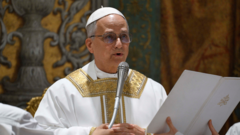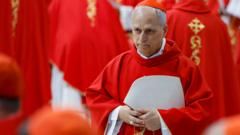In his final will, Pope Francis has requested to be buried in a simple tomb at the Papal Basilica of St. Mary Major in Rome, where several predecessors rest. The Pope, who served from 2013 until his passing in 2025, emphasized the importance of this location, having made numerous visits there throughout his papacy. His choice of burial reflects his dedication to the Virgin Mary and represents his spiritual journey.
Pope Francis Chooses Simple Resting Place at St. Mary Major Basilica

Pope Francis Chooses Simple Resting Place at St. Mary Major Basilica
Pope Francis expresses a desire for a modest burial in Rome's Papal Basilica, reflecting his humility and devotion.
April 21, 2025, 4:11 p.m. ET - Pope Francis, in a heartfelt document made public by the Vatican on Monday, declared his wish to be laid to rest in a modest and unembellished tomb situated at the Papal Basilica of St. Mary Major. This historic church is notably the final resting place of six other popes. The Pope specified that the inscription on his grave should simply read “Franciscus,” demonstrating his preference for humility even in death.
In his will, dated June 29, 2022, Francis expressed a desire for his earthly journey to conclude at this time-honored Marian shrine, a place of significance he deeply revered throughout his 12-year papacy. He was known to visit the Basilica at the beginning and conclusion of nearly all his apostolic journeys. Additionally, on his inaugural day as the Bishop of Rome in 2013, he took time away from the Vatican to pray at St. Mary Major.
The Pope's bond with the Basilica is underscored by his visits post-hospitalizations, including one of his final appearances on March 23 after a 38-day stay at Gemelli Hospital. His will further states that he wishes for his tomb to be fashioned simply, “in the earth” and free from elaborate decorations. He identified a specific location for his burial—next to the Pauline Chapel, which houses the Salus Populi Romani, an important Marian icon that he held in high esteem, aligning with Jesuit traditions of devotion.
This decision reflects both his personal faith and a broader message of simplicity and gratitude toward the Virgin Mary, whom he thanked for "her docile and maternal care." The icon, traditionally believed to have been created by Saint Luke the Evangelist, serves as a focal point for followers wishing to honor both the Virgin Mary and the legacy of Pope Francis.
In his will, dated June 29, 2022, Francis expressed a desire for his earthly journey to conclude at this time-honored Marian shrine, a place of significance he deeply revered throughout his 12-year papacy. He was known to visit the Basilica at the beginning and conclusion of nearly all his apostolic journeys. Additionally, on his inaugural day as the Bishop of Rome in 2013, he took time away from the Vatican to pray at St. Mary Major.
The Pope's bond with the Basilica is underscored by his visits post-hospitalizations, including one of his final appearances on March 23 after a 38-day stay at Gemelli Hospital. His will further states that he wishes for his tomb to be fashioned simply, “in the earth” and free from elaborate decorations. He identified a specific location for his burial—next to the Pauline Chapel, which houses the Salus Populi Romani, an important Marian icon that he held in high esteem, aligning with Jesuit traditions of devotion.
This decision reflects both his personal faith and a broader message of simplicity and gratitude toward the Virgin Mary, whom he thanked for "her docile and maternal care." The icon, traditionally believed to have been created by Saint Luke the Evangelist, serves as a focal point for followers wishing to honor both the Virgin Mary and the legacy of Pope Francis.





















